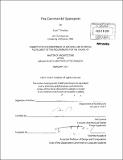The commercial spaceport
Author(s)
Ferebee, Scott T. (Scott Thomas)
DownloadFull printable version (18.17Mb)
Other Contributors
Massachusetts Institute of Technology. Dept. of Architecture.
Advisor
Joel Lamere.
Terms of use
Metadata
Show full item recordAbstract
Space tourism is poised for dramatic growth in the coming decades, as an industry once considered the exclusive purview of the military-science elite ramps up to serve the interests of mass commerce. The cost to private citizens for a trip to space today is over twenty million dollars, which buys an extra seat on a ten-day maintenance mission to the International Space Station. The cost to private citizens in 2040 will be twenty thousand dollars, enough to purchase a seat on a purpose-built spaceplane and spend two weeks in an orbiting hotel. In this context, the commercial spaceport represents a new transportation typology. It must respond to the new technical demands of space travel, as well as acknowledge its cultural import as a gateway for millions of people to the last and greatest of frontiers. Here, the stakes are raised: not only is the commercial spaceport responsible for the education, training, and rehabilitation of passengers, but also for'wowing'them. Here, everyone gets their money's worth. The site is Las Vegas, that most renown of frontier artifices. From the nuclear weapons explosions visible for decades from the strip to the ethos of excess that subverts the diurnal cycle, Las Vegas has always been a testing ground. As a threshold to the fringe, the spaceport is a natural extension of this narrative.
Description
Thesis (M. Arch.)--Massachusetts Institute of Technology, Dept. of Architecture, 2011. Cataloged from PDF version of thesis. Includes bibliographical references (p. 5).
Date issued
2011Department
Massachusetts Institute of Technology. Department of ArchitecturePublisher
Massachusetts Institute of Technology
Keywords
Architecture.